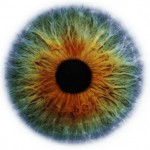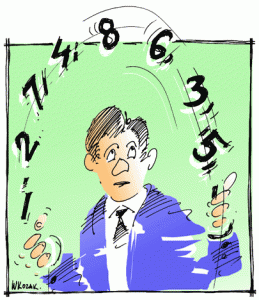Simply stated, someone who studies human behaviour and the brain (a Behavioural Neuropsychologist) can help you:
(1) select the best participants for an eye-tracking study,
(2) determine the number of participants required,
(3) design the eye-tracking task to get usable results,
(4) design task instructions, and
(5) understand how study results apply to the target population.
Why Having a Behavioural Neuropsychologist on Your Eye-Tracking Team is a Good Idea

Tracking Your First Eye
Imagine if you will, that an associate of yours has just lent you an eye-tracker and you’re keen on using it to optimize your web site. You want to know what people are looking at and you want to modify your web site based on this information. To investigate this, you sit a co-worker down in a chair in front of a computer and configure the equipment to track their eyes. Then you display your web site; the eye-tracker shows where they look when various pages appear. It also shows where you co-worker looks when they stare blankley ahead, confused and perplexed, asking you, “What should I do?”.
Making Eye-Tracking Data Useful
While you might have been able to successfully track a few eyes while people viewed a few web pages, the process of obtaining useful eye-tracking results requires some thought and experience. Considerable thought and experience, actually. My recommendation is that you find someone who has a working knowledge of brain function and has done behavioural research to help you obtain useful data from your eye-tracker. This article is about why this is a good idea.
Let’s assume that your goal is to optimize your web site; to get as many people who arrive on the site to make a purchase, or read about and digest an idea. Without getting into the details of what eye-movement and eye-gaze means, let’s focus on the role of a behavioural neuropsychologist in the design of the actual ‘experiment’ that will help you optimize your web site.
The Role of the Behavioural Neuropsychologist
The behavioural neuropsychologist can help you get the most out of your eye-tracking study by helping you design the study correctly. They can do this because they have studied the science of behaviour and specialize in understanding the relationship between brain activity and human behaviour. They research WHY people do what they do, which is exactly what you want to find out! They can help you (1) select the best ‘type’ of participants, (2) determine the number of participants needed, (3) determine how to investigate the specific behaviours of interest, (4) design task instructions, (5) and understand how study results apply to the target population.
(1) Selecting the Best Type of Participants
When examining how people interact with their environment, the question always arises, “who are the best people to use for my study?” There are a number of human factors to consider including: expertise, gender, and the interest study participants might have in your product or service.
- Expertise: training and experience. People often seem to have their own way of doing things and often it seems that you can predict what people will, or won’t do, before they enter the room. My own experience with eye-tracking is that engineers generally do things way differently than ‘normal’ people. Similarly, my own neuropsychology colleagues, familiar with seeing the behaviour of students who study psychology, were at first amazed at the bizarreness of an engineering approach to completing standard behavioural psychology tasks. Engineers have been trained to apply algorithms to solve problems, and hence, their training and expertise affects how they behave in the real world. They apply strategies that are not typical of other populations. Hence, you might reconsider using an engineer in your study if you want to understand the average person. (Unless of course, you wish to understand engineers!)
- Gender: male versus female. Remember gender ‘equality’ movements of the past? Remember when we were told that males and females are the same? These days the data are telling us that the genders differ in many ways. Behaviourally speaking, it is not entirely clear whether or not these differences are simply the result of experience and training. A fun factoid that I recently acquired is that most behavioural rat research is conducted on male rats. I’ve been told that female rats are much more variable than males, and for this reason, it is harder to use them in research. My own experience with human study participants is that females are generally more variable than males (when it comes to spatial navigation). The take-home on this point is that there is a good chance that two similar studies, one with only males versus one of only females might have different outcomes. Always consider gender in your study.
- Interest in your product: interest versus indifference? If you’re examining how people interact with your site, it is important to remember that people who are genuinely interested in your product will probably behave differently than people who are participating in your study simply for the ten or twenty dollars (a standard incentive to get participants in behavioural studies) you are giving them. Since the objective of a product site is generally twofold: (1) to sell to people who know and are loyal to the product, and to (2) convince people to buy your product who are new or are just ‘surfing’, you probably want both types of people in your study. You should probably examine the resulting eye-tracking data of each group separately so that you really get a feel for how features of your site relate specifically to each group.
(2) Determining the Number of Participants Needed
“How many people do I need in my study?” is another important question. This is a number that people always like to optimize because it directly relates to the cost of the study. You don’t want too many people because that increases the cost of the study, but you want enough people so that you can be confident in the results.
- Variability of the group of people you selected. If you want to know about males, females, experts (engineers for example), non-experts (average human population), and those who are interested, and indifferent, you probably have quite a bit of variability on your hands. Variability in people generally leads to large variance in your results. Variance is something you want to strategically minimize to gain confidence in your results. Generally, it is best to be very specific about the question you are investigating and in your web site optimization goal. For example, you might shape your study to find out what engineers look at on your web site and then optimize your site for engineers. By doing so, you will probably require fewer participants to achieve your goal (particularly if those engineers you choose are male). By strategically selecting your participants, you can minimize the costs associated with your study.
- Confidence you need to have in the results. Determining how confident you need to be in your result can be a little confusing and it is often useful to simply follow conventional methods. Often 95% confidence is acceptable in behavioural research. This means that you can be confident that 19 in 20 people will act as the study results have predicted. This said, when dollars are the main concern, 99.9% confidence is better than 95% confidence because you don’t want to risk making a poor design change to your site that results in lost income. However you must remember that getting 99.9% confidence might require many more study participants (increased study cost). A researcher who has experience doing behavioural research can help predict how many people will be required to attain required confidence levels.
(3) Deriving Usable Results from Eye-Tracking Data
Planning a study so that the resulting data can be easily analyzed, and usable results can be obtained is a fundamental skill of someone who has been trained in behavioural research. A Behavioural Neuropsychologist who has experience with eye-tracking can help solidify your goal of optimizing your website into some tangible research questions and apply the appropriate statistics to get the required answers.
- Formulating a statistically testable research question from the general requirement of web site optimization. Having some ideas about what comparisons can be made using an eye-tracker, and how to do the statistical analysis to answer specific research questions is a fundamental part of making all of this work. Let’s consider a simple example where a web page has two links. Link A is on the left-hand side of the page and Link B is on the right-hand side of the page. You want to know if there is a real difference between how many people look at link A versus link B. From your web site logs (or Google Analytics data) you know that on average, more people click link B than link A.
However in this example, we are supplementing our click analysis using eye-tracking data to measure covert behaviour. Eye-tracking will tell us where people have looked and might tell us why people have not clicked. It is a safe assumption that people probably won’t click on a link they have not looked at.
There are multiple possible research questions that may or may not include the factors of Gender, Expertise, and Product Interest described above. You might ask if there is a relationship between eye-gaze at A and B (how similar are they) and if there is a gender difference. For example, is there a relationship between the duration males look at A and the duration males look at B? Does this differ from females? Alternatively you might ask, is the latency from the time the web page appears on the screen to when males look at A and look at B different? Subtle differences in the specific question you are asking might require important differences in how the experiment is formulated and how the data collection is approached. The mechanism used to reveal information from the data in the cases described above is called hypothesis testing and it requires that the statistical test you do after data collection be known before the experiment begins.
- Finding information hidden in the data. One key advantage to having a neurospsychologist around is that they have used statistics to obtain hidden information from the data. For example, often unexpected results can be found by applying multiple types of statistical tests in a variety of ways on the data. This doesn’t fit within standard hypothesis testing rules and regulations but it does help you understand your data and find effects that might be new to you. We can look for relationships between things like Gender, Expertise, and Product Interest with the eye-tracking data collected. For example, you might find that females look at B BEFORE they look at A and that this behaviour does not seem to be present in males. Now this is something potentially very useful for web site optimization and you can probably use this to improve your site performance. It would be unfortunate if money were spent on an eye-tracking study and important information, hidden in the data, was not uncovered because the appropriate statistical tests were not run to reveal it.
(4) Designing Task Instructions
A question that I have rarely been asked when talking with people about eye-tracking analysis of web sites is, “What instructions should be used to guide the actions of study participants?” The fact this question is asked so rarely suggests that it isn’t on people’s minds. Task instructions are very important. They are so important that there is a whole body of research specializing in how instructions affect what people do.
If you really want to study bona fide human behaviour, no instructions are best. However, a study with no instructions isn’t realistic: you have to tell them something! Given that we want as little variability in the behaviour of study participants as possible, the ideal thing to do is to use the same instructions for all participants in the study. While this seems like a solid idea in theory, different peoples use and response to identical instructions is different ways. And this contributes to more variable data. For example, sometimes people don’t understand the instructions given, they have their own interpretation of the instructions, or they forget what was said right after the instructions are given. This is variability that you probably don’t want to appear in the final result of the study.
- Get an experienced professional to design your task instructions. A Behavioural Neurospsychologist who has had experience with these situations, has been trained to deal with the problems associated with task instructions. They have experience designing task instructions.
- Get an experienced professional to actually run study participants. These people are not necessarily Behavioural Neurophysiologists, but they have been trained to run study participants and know the value of doing things ‘properly’. They have had experience ‘guiding’ people along when they have forgotten why they are there. They have ‘already’ made their mistakes and will hopefully spare you the headache of learning on your dime.
(5) Understanding How Study Results Apply to the Target Population
Finally, the last key element that I will talk about that a Behavioural Neuropsychologist can help you with is in understanding how the results of your study apply to the general human population. Said another way, it is very important that you know how your study applies to the population of existing and potential customers. A Behavioural Neuropsychologist will use all of his or her power and knowledge to design the study to represent your target population. When this is done correctly, the confidence numbers of 95% or 99.9% that describe the sample of the population used in the study can be applied to the target population of potential customers out there on the internet.
Summary and Conclusions
It is not sufficient to simply track eyes; what you need is a small study of what peoples’ eyes do when they look at your web site. Partnering with someone who specializes in behavioural psychology (studies the relationship between brain function and human behaviour) can maximize your investment in eye-tracking. They will help you:
(1) select the best participants for the study,
(2) determine the number of participants required,
(3) design the task to get usable results,
(4) design task instructions, and
(5) understand how study results apply to the target population.
StepForth Web Marketing Inc. and I (Dr. Philip Michael Zeman) are currently investigating a partnership to offer eye-tracking analysis of web sites. In order to launch this new service and build our dossier we are willing to provide significant discounts for parties interested in having eye-tracking conducted on their site. We are accepting inquiries by email and phone – here is our contact information.
For more information about web marketing and web site optimization services see https://www.stepforth.com/. For more discussion about Eye-Tracking and related brain activity analysis see http://www.brainandvision.com
—More Background—
What is Eye-Tracking?
Tracking eye-movement allows one to identify where people look on a web page. It shows: where people spend their time looking, the sequence in which people look at things on a page, what they do not look at, and reveals how visitors separate (or ‘chunk’) information on the screen.
[youtube width=”638″ height=”396″]https://www.youtube.com/watch?v=hy3Hmt4nk7I[/youtube]
Why is Eye-Tracking a Good Idea?
Many organizations are using eye-tracking to optimize their web site performance: to make information easier to find, and to increase web site conversions. These include: Microsoft, Xerox, The New York Times, Ask.com, Marriott, Sprint, among others. Eye-tracking analysis of a web site is scalable, meaning that the costs associated with it can be reduced when the behaviour of specific markets or specific users is examined. It can be made very affordable to small business.
Eye-Tracking versus Web Site Usability?
Eye-tracking is a science of human behaviour—covert human behaviour. The goal is to try to see what is going on in people’s heads and use this information to improve site performance.
In contrast, web site usability is about making it easy to use a web site. It is the theory of web site design. Eye-tracking actually tells us empirically about the effectiveness of your specific web site design. It tells us how we might modify a site to optimize site performance after all the theory of usability has been applied.


